Blog
Getting Hands-on with Loopcloud DRUM and PLAY
20 Dec '2023
Take Loopcloud's innovative DRUM and PLAY plugin suite for a spin and find out how to supercharge your music production skills.
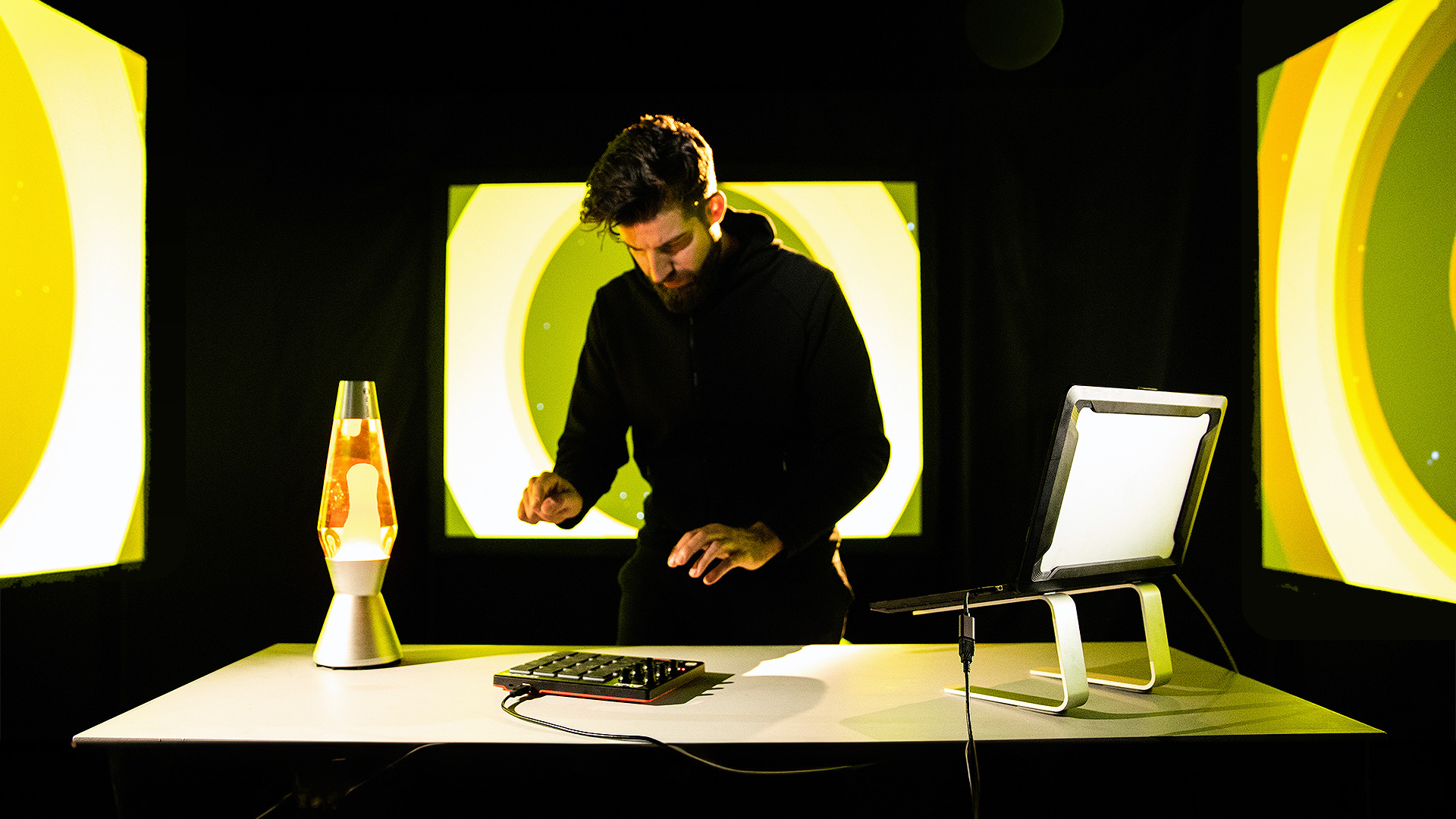
With a Loopcloud subscription, not only do you get access to millions of royalty free samples from top artists, producers and labels in our diverse catalogue, you also unlock the door to our awesome plugin suite. That’s right, Loopcloud comes stocked with DRUM and PLAY, two innovative music making tools that will inspire you to reach new creative heights in your DAW.
In fact, Loopcloud DRUM and PLAY are so comprehensive that you can build an entire track with them, and that’s exactly what we’re going to do here. Buckle up, because we’re going to take you for a spin and build a beat in Ableton Live whilst exploring the full range of powerful features in each plugin.
What are DRUM and PLAY?
Both DRUM and PLAY are premium virtual instruments that work as plugins in any DAW, and will help you to create pro-quality beats and melodies with ease.
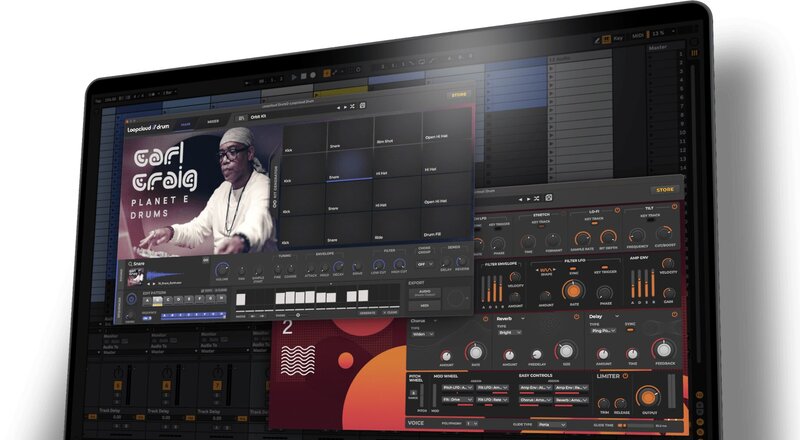
DRUM is designed for programming beats. Load any sample into the 16-pad drum rack, or pick a pre-made kit designed by professional sound designers specifically for DRUM. Tweak your samples and program your beats all from within the plugin itself and then export your beat as either MIDI or audio by simply dragging and dropping.
PLAY is an advanced sampler. Choose from one of the many instruments designed by professional sound designers and alter the patches with LFOs, filter envelopes, effects, sample editing and much more.
Building a beat with DRUM
When working on hip hop and electronic music, the drum beat is often a good place to start. It provides us with a solid rhythmic base upon which we can write basslines, melodies and chord progressions. It also often helps us to define the genre we are working in, as sub genres often have specific rhythmic characteristics.
Start by loading Loopcloud DRUM in your DAW. You will be presented with a drum rack with DRUM’s Basic Kit loaded. Open the Store using the button in the top right of the UI. From here you can browse through the different DRUM packs available, and click on a pack to explore the different kits available.
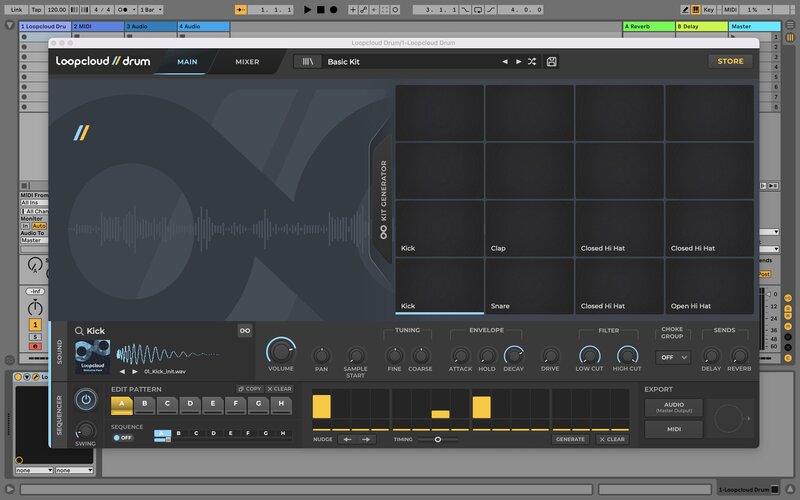
Today we’ll build a house beat, so the Funky House Producer EXP DRUM pack will work well for us here. Add the pack to your library and load it from there. We’ll select the Hive Kit.
DRUM has a powerful sequencer built in which allows us to program beats. Let’s build a basic beat with a four kick, a clap on every offbeat and a hat pattern. To add some swing we’ll use the timing slider to delay the open hat.
Each sample loaded in the DRUM drum rack can be tweaked. Adjust the volume, pan, tuning, envelope, drive and filter of each to hone in on a percussive flavour that sounds good to your ears.
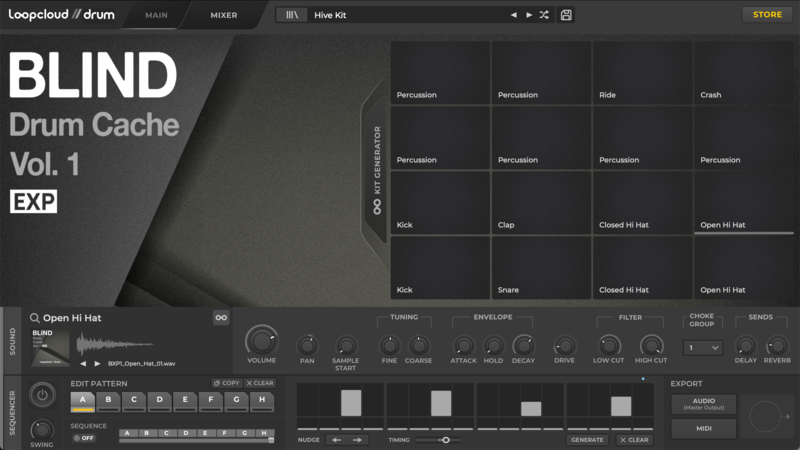
Opening the Mixer view gives us precise control over the balance and effects parameters of each mixer channel. DRUM provides delay and reverb sends and four master effects: Crush, Drive, Filter and Limiter. We’ll send our hats and claps to the reverb and beef up the whole beat with some drive and the limiter.
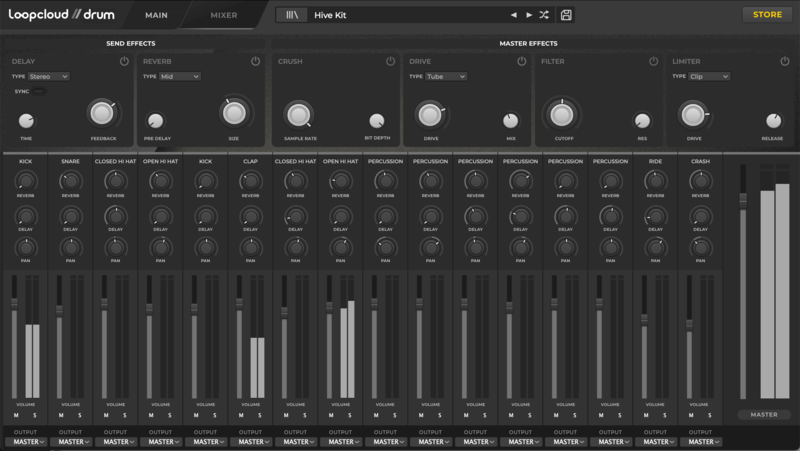
Once you’ve built a beat in DRUM you can export it as either MIDI or audio to work on in your DAW. In the Main view simply click either audio or MIDI in the Export section, and a WAV or MIDI file will become available for you to drag out into a track.
Creating a bassline with PLAY
Now that the drums are taken care of, let’s write a bassline with Loopcloud PLAY using one of the patches in the stock Intro II Bass pack. The patch Elated Bass is a perfect tight bass sound for house music. It has a bassy weight but also nice mid-range energy.
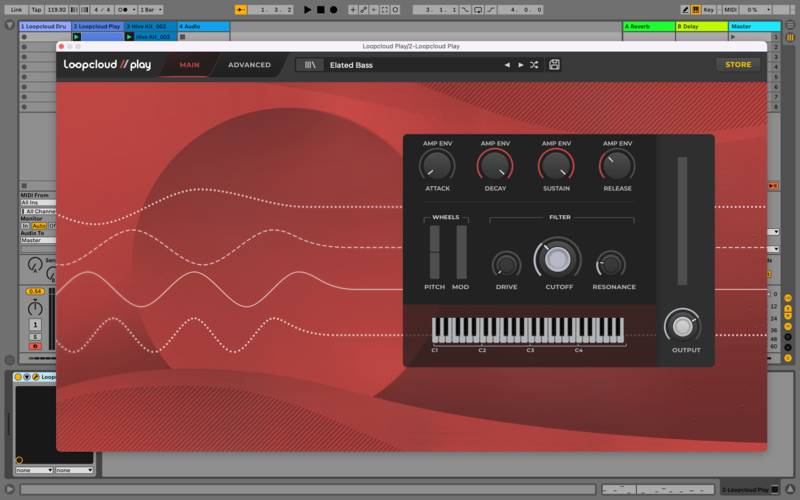
With our MIDI pattern written let’s start tweaking the sound. Firstly we’ll roll off some of the mid-range frequencies by bringing the filter cutoff to around 150Hz.
For some control over the vibe of the bassline we can assign the filter cutoff to the mod wheel, and as the track builds we’ll open up the filter on the bass, adding energy and sonic interest. To bake this into the track make sure to record automation as you do so.
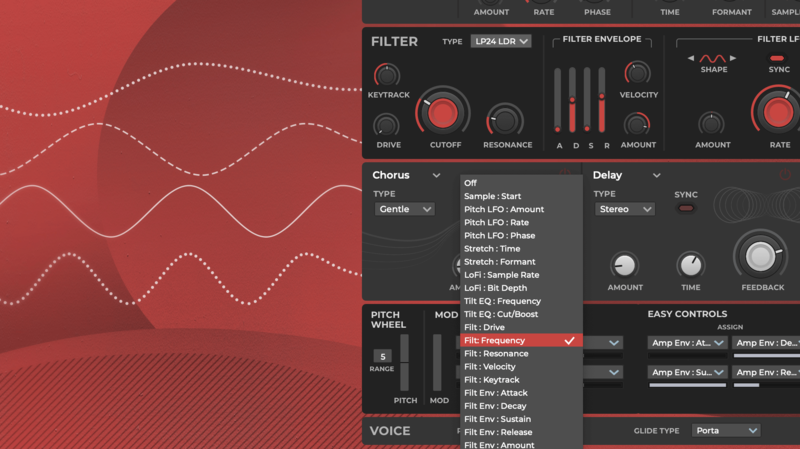
Alternatively, in Ableton Live, Loopcloud PLAY’s main parameters are already configured to be automatable. Click the arrow in the Ableton plugin interface to access these values, or select them from the automation drop down menu in the track header.
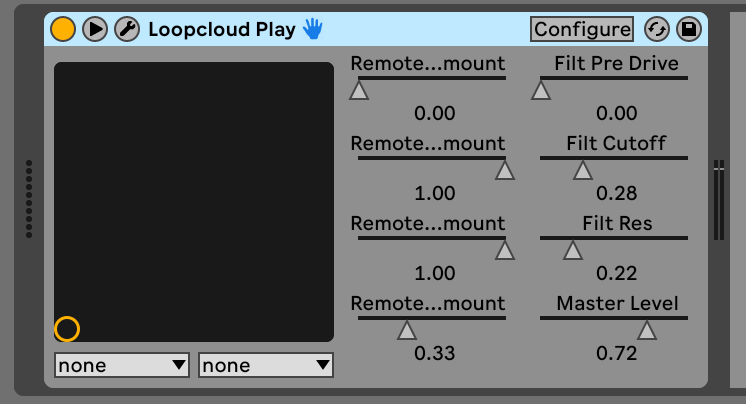
To make the bass hit a little harder we’ll tighten it up by bringing the release of the amp envelope down, and by adding a small amount of drive with the effects section.
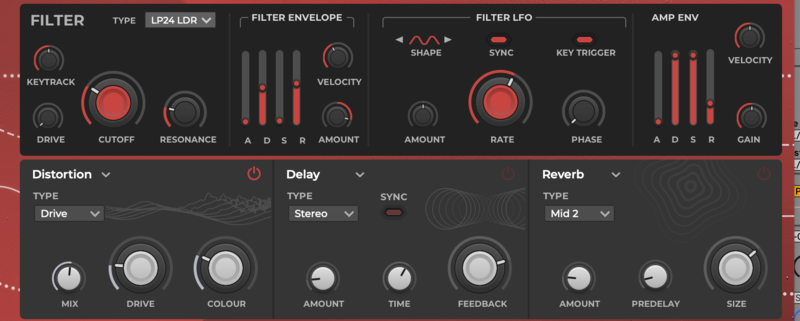
Adding keys with PLAY
With the bass and drums of our house track down, we have a basic groove around which we can construct the rest of our track. Let’s continue with some keys.
This time we won’t use an instrument from a pack – instead we’ll build a patch from scratch using the basic wave shapes that come with Loopcloud PLAY as standard. By loading basic waveshapes in Loopcloud PLAY’s sampler we can treat the instrument as a subtractive synth, using the built-in filter, amp envelope, effects and more to shape a clean keys patch.
Load the patch FAWV Basic Saw from the Saved Kits pack in the library of PLAY. This loads a simple saw wave in the sampler. We’ll pencil in a chord pattern so that we have some source MIDI to work with and then start programming our patch.

Start with the amp envelope. We want to keep the attack very quick so that the chords are sharp and punchy. To emphasize the transient of the chords bring the sustain value down slightly. To smooth the chords out somewhat, nudge the release value a bit higher.
Time to shape the sound tonally with the filter module. We’ll bring the cutoff of the LP24 filter to around 4kHz and then add a medium amount of attack to the filter envelope. This gives some nice movement to our chords. To make the sound a little less “pure” we can tweak the saw wave sample with the modules in the top row of the instrument.
The Pitch LFO allows us to add some pitch variation to the samples. You don’t really want to overdo it with this control, but some subtle pitch variation will create the effect of analogue warmth. With around 10% pitch variation we get the sound of a slightly out-of-tune vintage synth.

The Stretch module warps the sample, and you can also control the formant shifting. We won’t use this here, but it’s a useful feature to be aware of if you want to transform your source sound.
We will, on the other hand, use the Lo-fi module. This works as a bitcrusher, and reducing the bit depth and sample rate slightly of our patch helps to create the illusion that the synth sound is coming from a retro sampler like an Akai MPC.
Next, we’ll add a bit of brightness with the Tilt module. This unit allows us to alter the general tonal balance of the sound by boosting or cutting high or low frequencies. We’ll boost frequencies above 2kHz by about 1dB.

Finally, we’ll add some chorus and reverb with three effects modules engaged simultaneously to widen the sound and give it some spatial depth.
Getting experimental
Beyond the fundamentals of drums, bass and keys that we’ve created so far, we can start to build out the rest of the song structure using both DRUM and PLAY in a slightly more experimental way. Though Loopcloud DRUM is designed for drum programming and PLAY for tuned instruments, don’t let this stop you from getting creative!
One cool use for DRUM is programming vocal chops. DRUM allows you to import your own samples into the rack, and nothing is stopping you from importing sounds that aren’t drum hits.
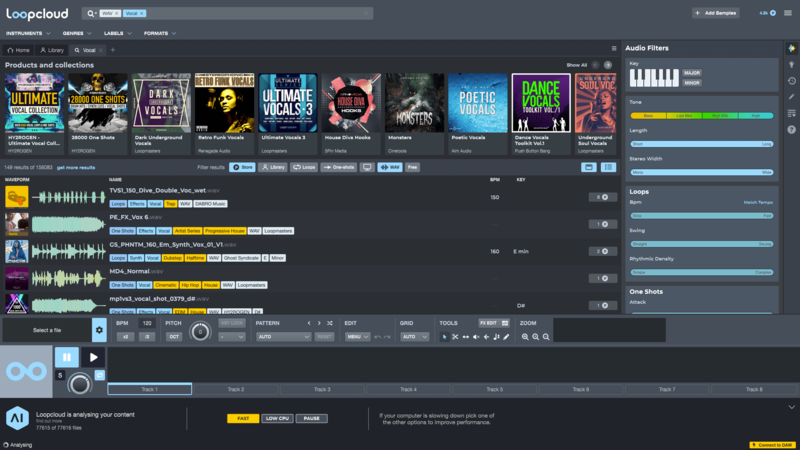
To create a fun vocal chop instrument that you can jam on with your external MIDI keyboard or drum pad, cut up a vocal sample from the Loopcloud library and load a slice on each drum pad. You can now play around with the instrument over the rest of your beat to create a classic house and garage vocal lead.
After should now have a feel for the vast capabilities of both Loopcloud DRUM and PLAY. Both plugins are incredibly powerful music-making tools and it is totally possible to build an entire track with only the Loopcloud plugin suite.
One of the uniquely powerful features of both DRUM and PLAY is that you get access to exclusive drum kits and instruments designed by the likes of Ronnie Size, Jody Wistenof, and other world-famous artists and sound designers. With a Loopcloud subscription, you can purchase these packs and immediately play meticulously designed instruments in your DAW.
For inspiration on how to use the Loopcloud plugin suite in your music make sure you check out our guides to writing Tech House and Lo-Fi with Loopcloud PLAY.

